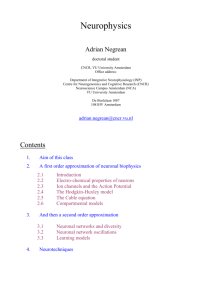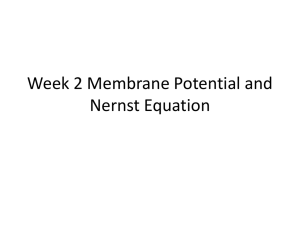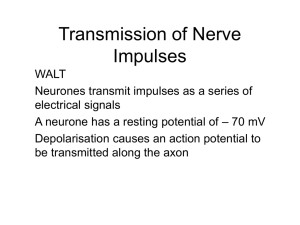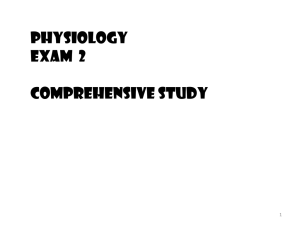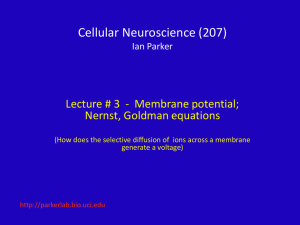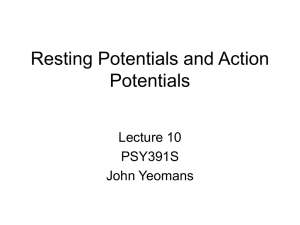ion
advertisement
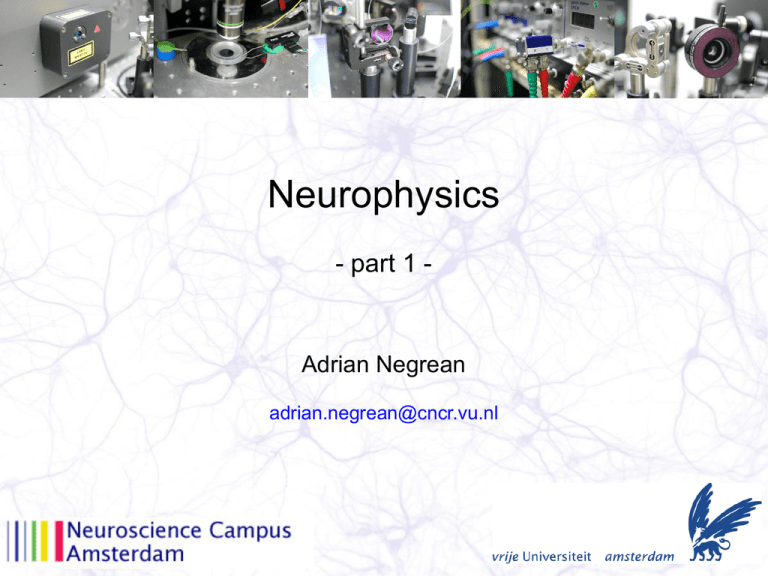
Neurophysics - part 1 - Adrian Negrean adrian.negrean@cncr.vu.nl Contents 1. Aim of this class 2. A first order approximation of neuronal biophysics 1. Introduction 2. Electro-chemical properties of neurons 3. Ion channels and the Action Potential 4. The Hodgkin-Huxley model Introduction (4) (3) 1) Cell body 2) Axon (5) (1) 3) Apical dendrite 4) Basal dendrite 5) Synapses (2) histological staining of a single neuron in a rat brain (photo credits: Cristiaan de Kock, CNCR, VU, Amsterdam) Let’s watch a brief video clip for a quick check of what you (might) know about neurons: http://www.youtube.com/watch?v=DF04XPBj5uc&feature=related • Neurons connect to each other via synapses • Fast communication (a few milliseconds) occurs through Action Potentials • Action Potentials release neurotransmitters at the synapse • Neurotransmitters bind to “special gates” on the other side of the synapse and let in a “flood of charged particles” which start up a new electrical signal in the receiving neuron • A bunch of neurons forming intricate connections allows us to think imaginatively Q: How is this possible ? physically speaking ?! • There is a great diversity of neurons, and people are still struggling to classify them Electro-chemical properties of neurons • Membrane capacitance “ parallel plate capacitor “ C 0 A d • Ion-channels: 1) Leak-channels 2) Voltage-gated ion-channels 3) Ligand-gated ion-channels 4) Metabotropic ion-channels Structure of a voltage-gated potassium selective ion-channel from the Kv1.2 gene • Electrical circuit of a simple cell having: 1) Capacitance C 2) Leak ion-channels R 3) Membrane potential Vm …keeping in mind that there are ions instead of electrons • Ions and electrochemical potentials: A) A Cl- semi-permeable membrane separates a salty solution from water B) As time passes, Cl- diffuse, creating a potential difference A B E=0 Na+ClNa+ClNa+Cl- E=ECl water Cl- permeable membrane Na+ClNa+ Na+ ClCl- • Nernst’s equation for equilibrium potentials: Eion [ion ]out RT ln zF [ion ]in where z is the valence of the ion, R is the gas constant (8.315 J K-1mol-1), T is the temperature (K), F is Faraday’s constant (96.485 C mol-1) and [ion]o and [ion]i are the concentrations of the ion inside and outside of the cell respectively The membrane potential of a simple cell can be calculated using this formula if the membrane is permeable only to one ion type. • Goldman-Hodgkin-Katz equation for equilibrium potentials: (generalization of Nernst’s equation for membranes permeable to multiple ions simultaneously) pK K o p Na Na o pCl Cl i RT Vm ln F p K p Na p Cl i i o Na Cl K for example, the membrane relative permeability coefficients for the Squid Giant Axon are pK : pNa : pCl = 1.00 : 0.04 : 0.45 when the axon is at rest. …so if you know the ion concentrations inside and outside the cell at rest …and the relative permeability ratios …then using the GHK equation you can calculate the resting membrane potential of the cell but the simplest thing to do in practice is to just measure it Intracellular and extracellular concentrations of different ions (millimoles) given in parentheses for a typical mammalian neuron and their Nernst equilibrium potentials (mV). • Ion-channels: - membrane-bound proteins - conduct ions across the membrane - are selective for certain ions - they open/close in response to a wide range of stimuli: a) electrical b) mechanical c) chemical d) thermal e) optical f) intracellular • Ion-channel gating is a stochastic process example: an Ohmic leak channel C: Gramicidin A peptide has been added to a phospholipid bilayer membrane to form transmembrane channels that allow passage of ions. A: The formation of functional Gramicidin A channels can be seen as random step-increases in current when a potential difference is applied to the membrane. B: The size of the current steps is related to the applied potential through Ohm’s law. • when describing Ohmic single channel leak currents, the reversal potential has to be also taken into account: single channel current membrane potential I L g L E Erev single channel conductance reversal potential for the ions involved • for the great majority of ion-channels, the single channel conductance is not constant but depends on the membrane potential voltage-gated ion-channels Q: So what are voltage-gated ion-channels good for ? A: Action Potentials, among other many interesting examples watch video: The nerve impulse An Action Potential propagates down the axon, and causes the release of a neurotransmitter at the synaptic cleft watch video: Action Potential propagation Finally the released neurotransmitter binds to ion-channels in the postsynaptic neuron, and depolarizes the cell. watch video: Synaptic transmission Let’s have a closer look at what the ion-channels do during an Action Potential: watch video: Ion-Channels involved in the Action Potential main points: 1) Voltage-gated ion-channels have gates 2) These gates open/close with different speeds 3) The opening / closing of ion-channels is actually a change in the coformational state of the protein • Single-channel kinetics involved in AP production K+ channels - the opening of the channel requires 4 independent subunits to change conformation PK n probability for channel to be open k k=4 probability of a subunit to change conformation - the subunit open probability n is related to the membrane potential through a first order kinetic scheme closed / open subunit conformation voltage-dependent transition rates - in practice the voltage-dependent transition rates are fitted to measured data, still in this case, thermodynamic arguments give a good result here’s the thermodynamic argument: 1) the subunit contains a charged domain q that couples to the transmembrane electric field E=V/d 2) a movement of the subunit means that a fraction Bα from the charge q moved within the electric field E doing a work of q BαV 3) Boltzmann statistics says that the probability to make a transition to a state of higher energy, qBαV is proportional to: temperature exp(qBV / k BT ) Boltzmann’s constant energy separating the two states thus n (V ) A exp(qBV / kBT ) (in Chemistry this kind of equation is known as Arrhenius’s law describing reaction rates) - a similar equation can be written also for the reverse transition rate Na+ channels k=3 PNa m k h - in addition to three activation subunits m they also have an inactivation subunit h that closes the channel after a while, even if the activation subunits are open - same thermodynamic arguments as for the K+ channels The Hodgkin-Huxley model of AP’s - describes the phenomenon of Action Potential generation in neurons - the model was applied to the Squid Giant Axon and later generalized to other neurons (1) (2) (3) (4) time (5) using Kirchhoff’s laws: (the dot is a time derivative) I Na IK IL CV I inj g K n4 (V EK ) g Na m3h(V ENa ) g L (V EL ) capacitor current - now we have to add the single-channel gating kinetics for both Na+ and K+ as described before: n n (V )(1 n) n (V )n n (V ) 0.01 10 V 10 V exp 1 10 m (V )(1 m) m (V )m m n (V ) 0.125exp h h (V )(1 h) h (V )h m (V ) 0.1 - and specify also the channel conductances and reversal potentials V 80 25 V 25 V exp 1 10 V 18 m (V ) 4 exp V 20 h (V ) 0.07exp h (V ) 1 30 V exp 1 10 and the result is:


